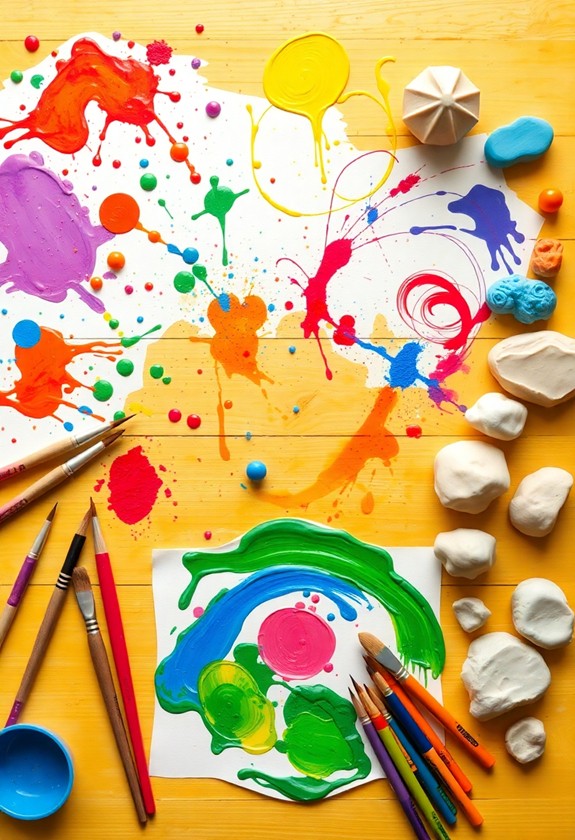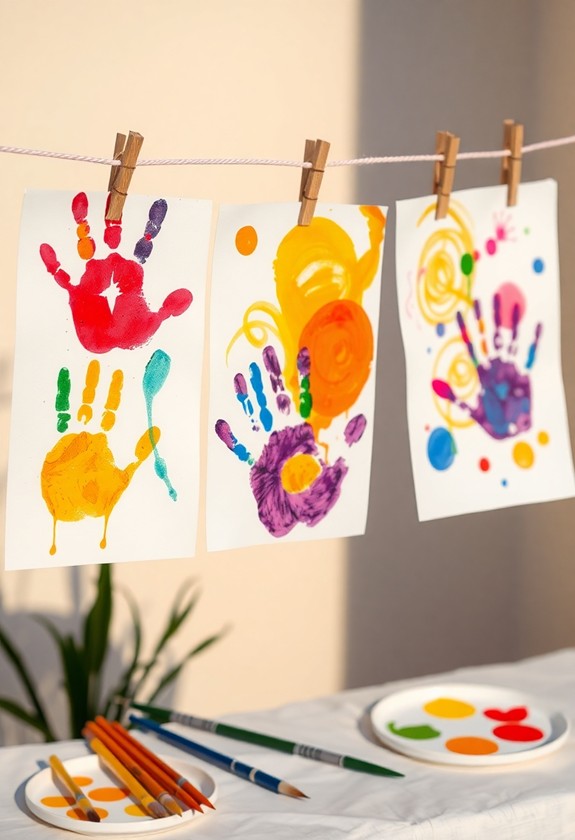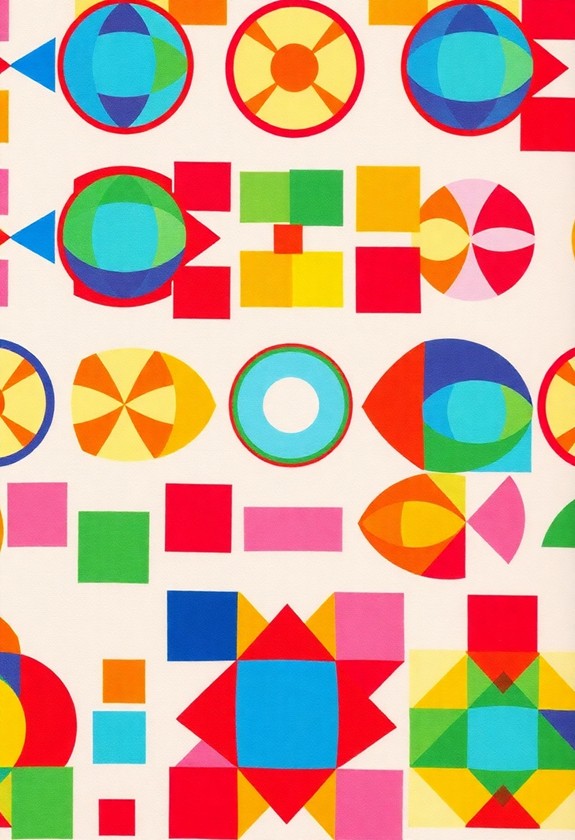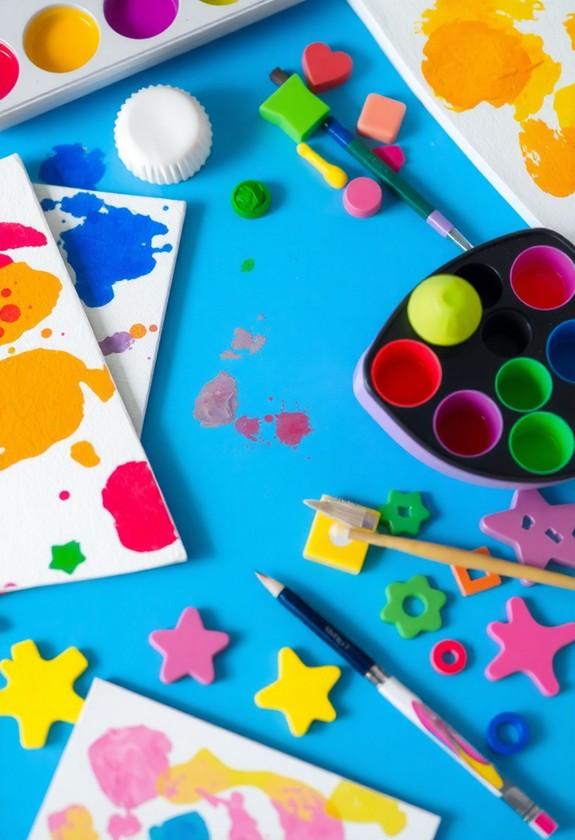Get ready to release your child's creativity with these 7 awesome art activities! Finger painting lets kids investigate textures and colors as they get messy. Playdough sculpting builds fine motor skills as they squish and mold. Nature collages bring the outdoors in for a unique twist. Scribbling with crayons is a classic way to boost coordination. Sponge painting creates fun patterns and textures. Paper tearing improves hand strength through ripping and gluing. And colorful rice art offers a sensory-rich experience! These activities aren't just fun – they're essential for your child's growth and development. Jump in to reveal how each activity can spark your little one's imagination!
Creative Highlights
- Finger painting enhances sensory exploration, fine motor skills, and promotes creativity in young children.
- Playdough sculpting develops dexterity, problem-solving skills, and encourages imaginative play.
- Creating collages with natural materials fosters a connection with nature while improving fine motor skills.
- Scribbling and drawing with crayons boosts hand-eye coordination and builds confidence in self-expression.
- Sponge painting allows for texture discovery and color experimentation, enhancing sensory awareness and creativity.
Finger Painting for Sensory Exploration
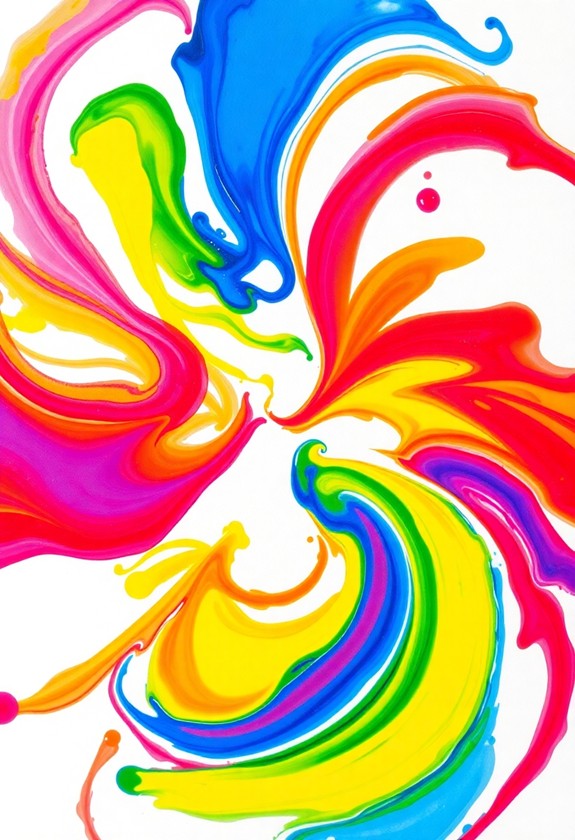
Though finger painting may seem like a messy activity, it's an excellent way for young children to examine their senses and develop fine motor skills. It's a sensory explosion! Kids get to squish, smear, and spread paint with their hands, feeling different textures and temperatures. Wow! Finger painting is particularly beneficial for children with Sensory Processing Disorders, as it can help reduce anxiety and promote sensory integration. This engaging activity additionally contributes to brain development by forming important connections as children concentrate on their artistic tasks.
Here's how to set up a finger painting session:
- Cover the table with newspaper
- Put on old clothes or smocks
- Provide washable, non-toxic paints
- Use thick paper or cardboard as a canvas
Let the creativity flow! Encourage kids to mix colors, make handprints, and examine patterns. They'll love swirling their fingers through the paint and watching it change. But wait, there's more! Finger painting further boosts:
- Creativity
- Self-expression
- Color recognition
- Emotional release
Playdough Sculpting for Fine Motor
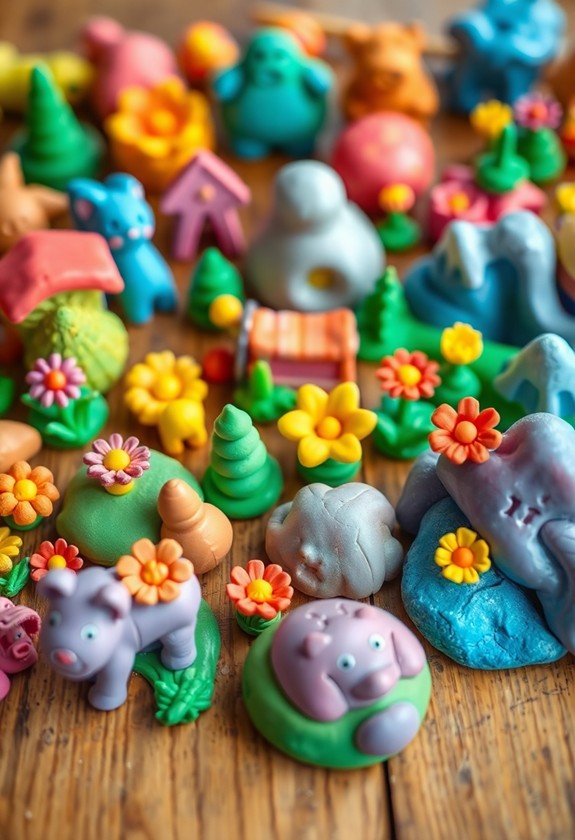
Playdough sculpting stands out among creative activities for developing fine motor skills in young children. It's a hands-on adventure that'll have your little ones squishing, rolling, and molding their way to stronger fingers and improved dexterity! This multi-sensory experience aids in memory retention and information processing, essential for early childhood development. Regular engagement with playdough additionally stimulates brain regions associated with problem-solving and creativity.
Ready to get started? Here's what you'll need:
- Colorful playdough
- Cookie cutters
- Plastic knives
- Rolling pins
Now, let the fun begin! Encourage your kids to:
- Roll snakes and coil them into spiral "snails"
- Create mini-sculptures of their favorite animals
- Build a playdough pizza with all the toppings
As they knead, pinch, and shape the dough, they're not just creating art – they're strengthening those important hand muscles! Plus, it's a great way to let their imaginations run wild. So, get ready to witness some dough-lightful masterpieces!
Collage Making With Natural Materials
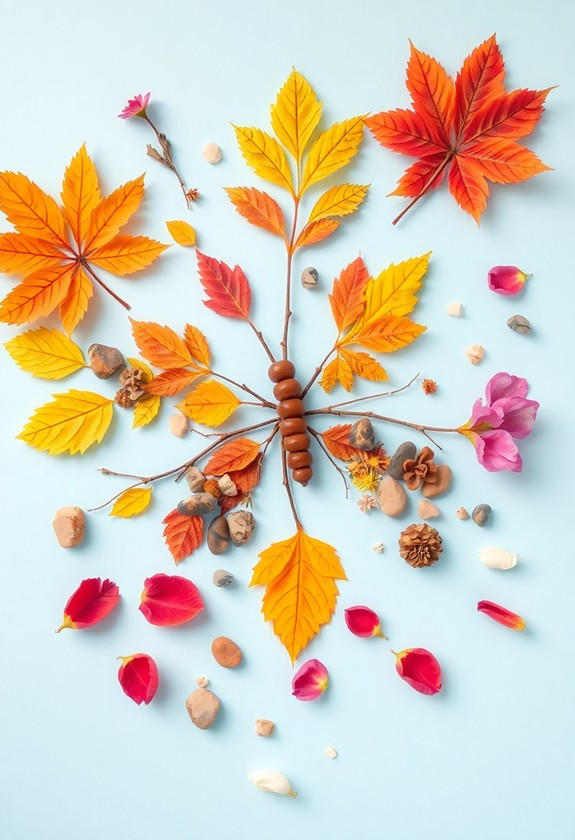
Stepping outside, we find a world of natural art materials waiting to be uncovered. Grab a basket and let's go on a treasure hunt! Look for:
- Colorful autumn leaves with intricate veins
- Smooth, round pebbles in various shades
- Delicate flower petals and sturdy twigs
- Fluffy dandelion seeds and wispy grass blades
Nurturing creativity in young children often starts with investigating the natural world around them. This activity not only encourages artistic expression but additionally cultivates a connection with nature.
Now, it's time to create! Arrange your findings on a piece of paper or cardboard. Play with shapes, colors, and textures. You can make a scenery, a face, or an abstract design – let your imagination run wild! Use glue to stick everything down. Don't forget to add a personal touch with drawings or paint. Your nature collage is a unique masterpiece that celebrates the beauty of the outdoors. It's a leaf-tastic way to boost creativity and fine motor skills!
Scribbling and Drawing With Crayons
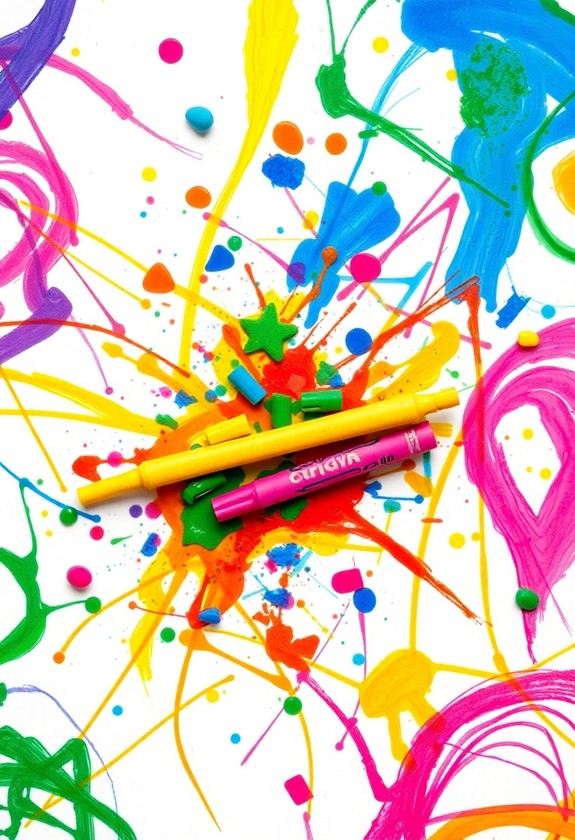
Imagination soars when a child grasps their first crayon. It's time to release their inner Picasso! Scribbling and drawing with crayons isn't just fun, it's a vital step in your child's development. Here's why it's so important:
- Boosts fine motor skills
- Improves hand-eye coordination
- Encourages self-expression
- Builds confidence
Non-toxic, washable jumbo crayons are perfect for little hands and guarantee mess-free creativity. Using washable crayons additionally makes clean-up on surfaces much easier for parents.
Ready to get started? Grab some paper and a box of crayons. Let your little one go wild! Don't worry about perfect pictures – it's all about the process. Encourage them to:
- Scribble freely
- Draw shapes
- Create colorful patterns
- Tell stories through pictures
Sponge Painting for Texture Discovery
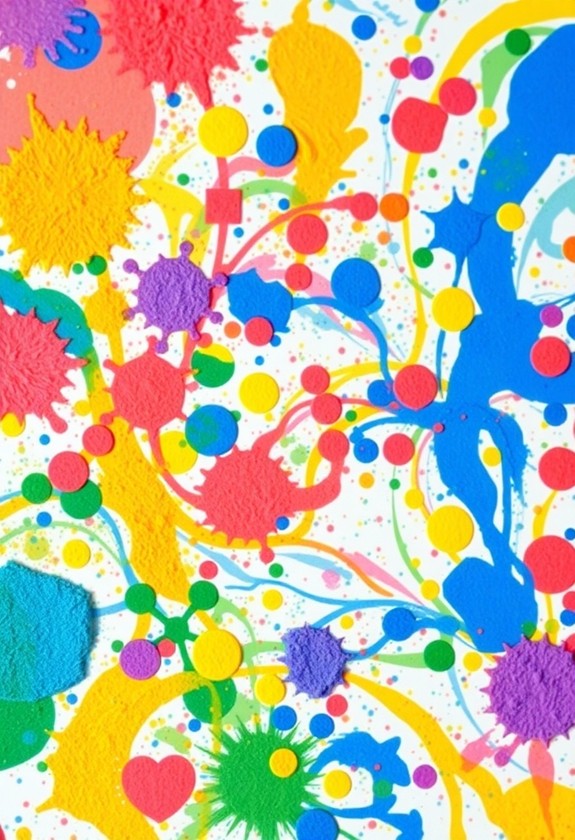
Along with crayons, sponge painting offers another exciting avenue for young children to examine art. It's a fantastic way to uncover textures and create unique patterns! You'll be amazed at how much fun your little ones have with this activity. Washable, non-toxic supplies are ideal for this project, ensuring easy cleanup and safety for your toddlers.
To get started, gather these materials:
- Natural and synthetic sponges
- Washable tempera paints
- Large sheets of paper
- Shallow trays for paint
Dip the sponges in paint and let your child go wild! They'll love pressing, dabbing, and swirling the sponges on paper. Watch as they realize how different sponges create various textures. Encourage them to mix colors and experiment with patterns. This hands-on experience helps develop fine motor skills and sparks creativity. Plus, it's a great opportunity to teach about colors and shapes. So, grab those sponges and let the artistic adventure begin!
Paper Tearing for Hand Coordination
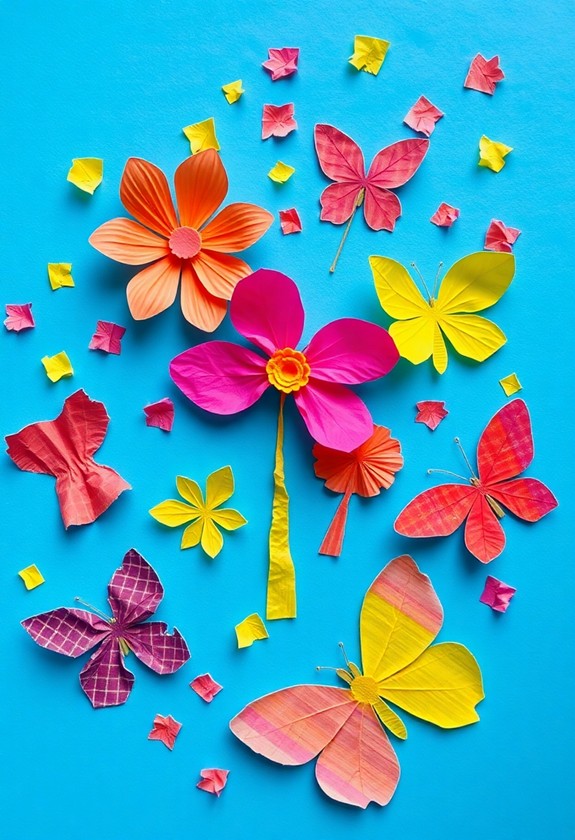
Paper tearing is an often-overlooked yet highly effective art activity for young children. It's a fantastic way to boost hand coordination and fine motor skills! Here's why you should give it a try:
- Improves grip strength
- Improves finger dexterity
- Develops hand-eye coordination
Ready to get started? Here's how:
- Gather colorful paper sheets
- Show kids how to tear paper into strips
- Encourage tearing different shapes
- Create a collage with torn pieces
But wait, there's more! Paper tearing isn't just about ripping — it's about creating! Let your little ones release their imagination by making torn paper animals, sceneries, or abstract art. They'll have a tear-ific time as they learn valuable skills. So, don't let this activity slip through your fingers. It's time to tear it up and watch your child's creativity soar!
Colorful Rice Art for Creativity
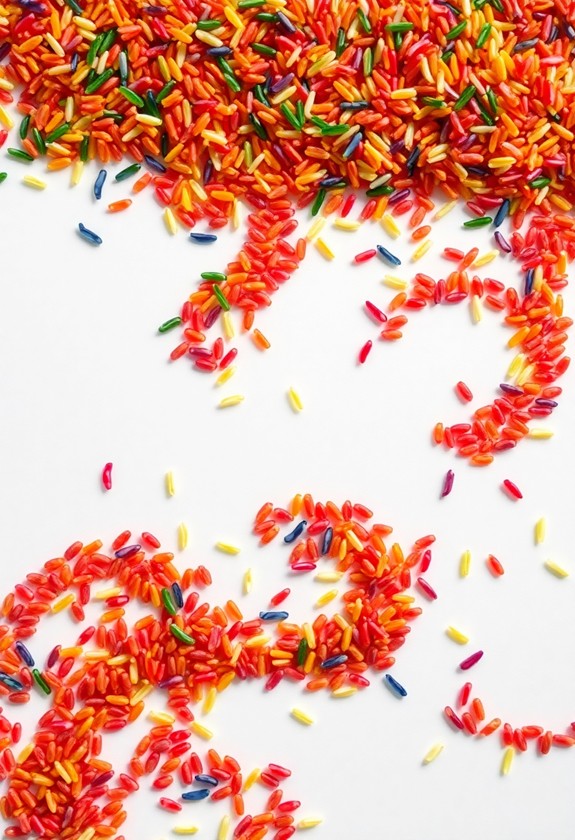
Colorful rice art offers a sensory-rich experience that ignites young children's creativity. It's an easy, affordable activity that'll have your little ones squealing with delight! To get started, grab some white rice and food coloring. Mix them together in ziplock bags for a rainbow of hues. Then, let your child's imagination run wild!
Here's what they can create:
- Radiant terrains with rice "grass" and "flowers"
- Colorful mandalas with swirling patterns
- Fun, textured animals with rice "fur"
- Abstract masterpieces bursting with color
Spread glue on paper or cardboard, then sprinkle the colored rice to bring their ideas to life. It's like painting, but with a twist! This activity helps develop fine motor skills and color recognition. Plus, it's a blast for sensory exploration. So, roll up those sleeves and immerse yourself in the wonderful world of rice art!
Curious Little Questions
How Can I Make Art Activities Safe for Toddlers?
Ready to release your toddler's inner Picasso? Safety first! Here's how to make art activities a blast without the risk:
- Use non-toxic, washable materials
- Opt for large, chunky crayons and markers
- Supervise at all times
- Keep small items out of reach
- Use child-safe scissors
- Cover surfaces with easy-clean materials
And voila! You've created a mini masterpiece studio that's safe and fun. Remember, creativity can get messy, but that's half the fun! Let their imagination run wild as you keep a watchful eye.
What Are Age-Appropriate Art Supplies for Preschoolers?
You'll love these age-appropriate art supplies for preschoolers! Get ready for colorful fun:
- Chunky crayons and washable markers – perfect for little hands!
- Child-safe scissors – snip, snip hooray!
- Finger paints and washable tempera paints – messy masterpieces ahead!
- Play-Doh or modeling clay – squish and shape away!
- Large paintbrushes and sponges – for big, bold strokes!
- Stickers and construction paper – stick 'em up!
How Do I Encourage a Child Who's Hesitant About Art?
Imagine a blooming flower, hesitant to open its petals. That's your child with art! To encourage them, start small and make it fun. Try these ideas:
- Set up a cozy art corner with comfy seating
- Introduce mess-free options like stickers or coloring books
- Join in and create alongside them – it's bonding time!
- Praise their efforts, not just results
- Investigate different mediums – maybe painting isn't their thing, but clay is!
Can Art Activities Help Children With Special Needs?
Art activities can be a game-changer for children with special needs. They're not just fun, they're fantastic tools for development! Here's why:
- Boost motor skills and coordination
- Encourage self-expression and communication
- Improve focus and concentration
- Build confidence and self-esteem
You'll be amazed at how art can help kids overcome challenges and release their creativity. It's like unlocking a colorful world of possibilities! So grab those brushes, crayons, or clay – it's time to let your child's inner artist shine!
How Often Should Young Children Engage in Creative Art Activities?
Let's paint a picture of the perfect art schedule for your little one! You should aim to engage your child in creative art activities every day. It's a piece of cake! Here's why:
- Daily art boosts creativity and expression
- It develops fine motor skills
- Art helps with problem-solving abilities
Even 15-30 minutes a day can work wonders! Mix it up with drawing, painting, sculpting, and crafting. Remember, it's not about perfection, but about having fun and learning. So, grab those crayons and let the creativity flow!

